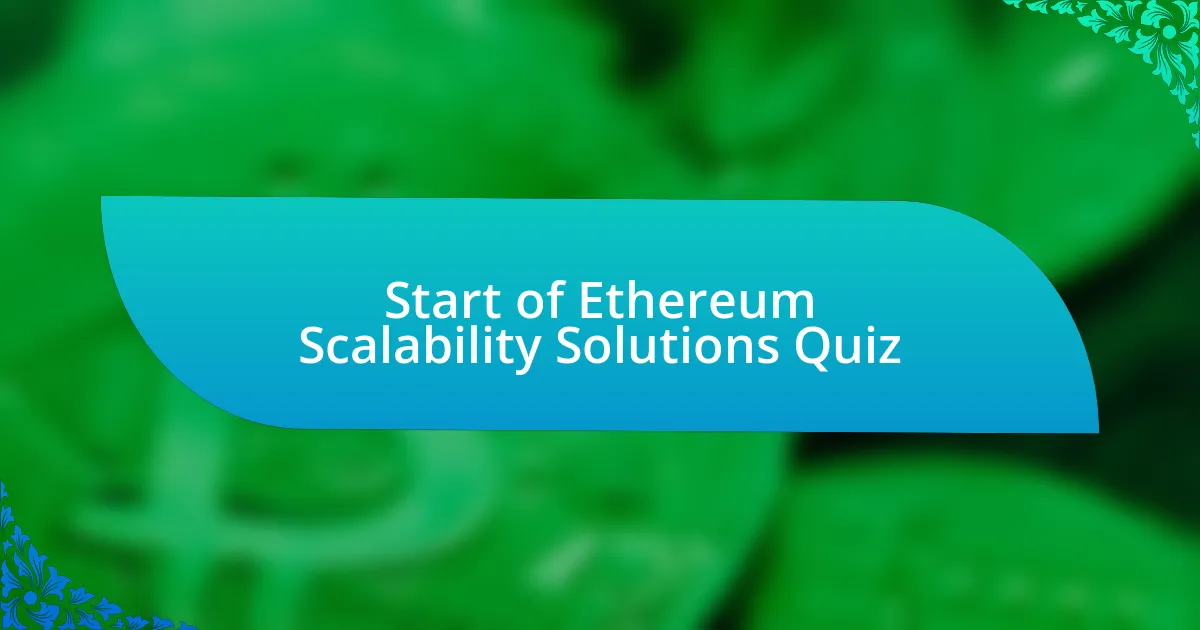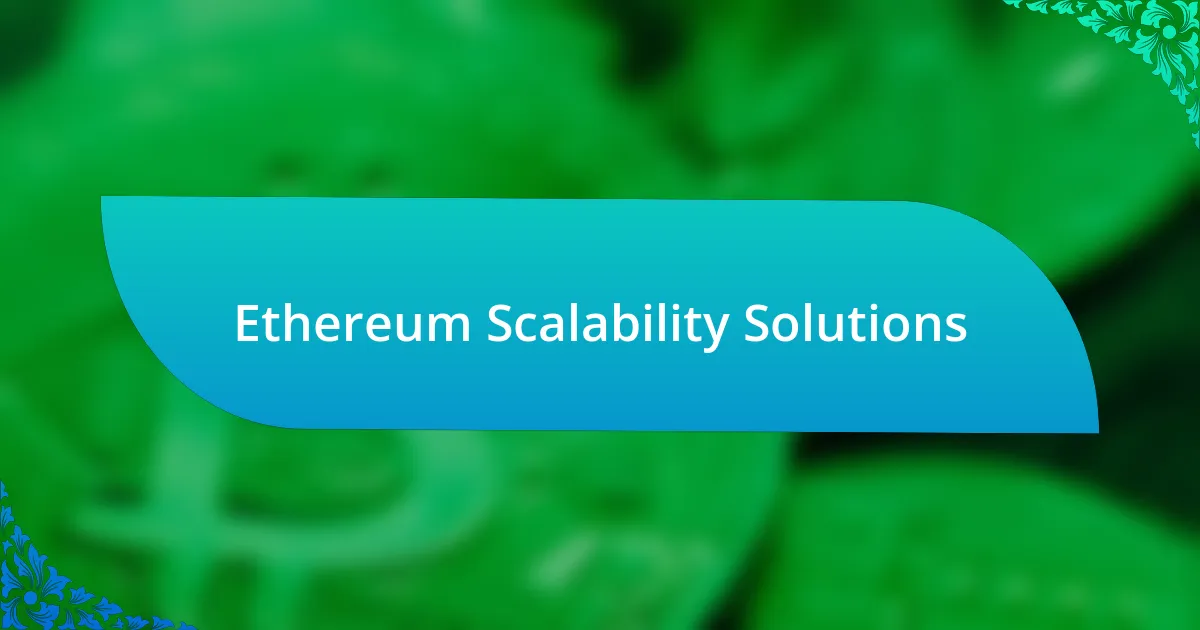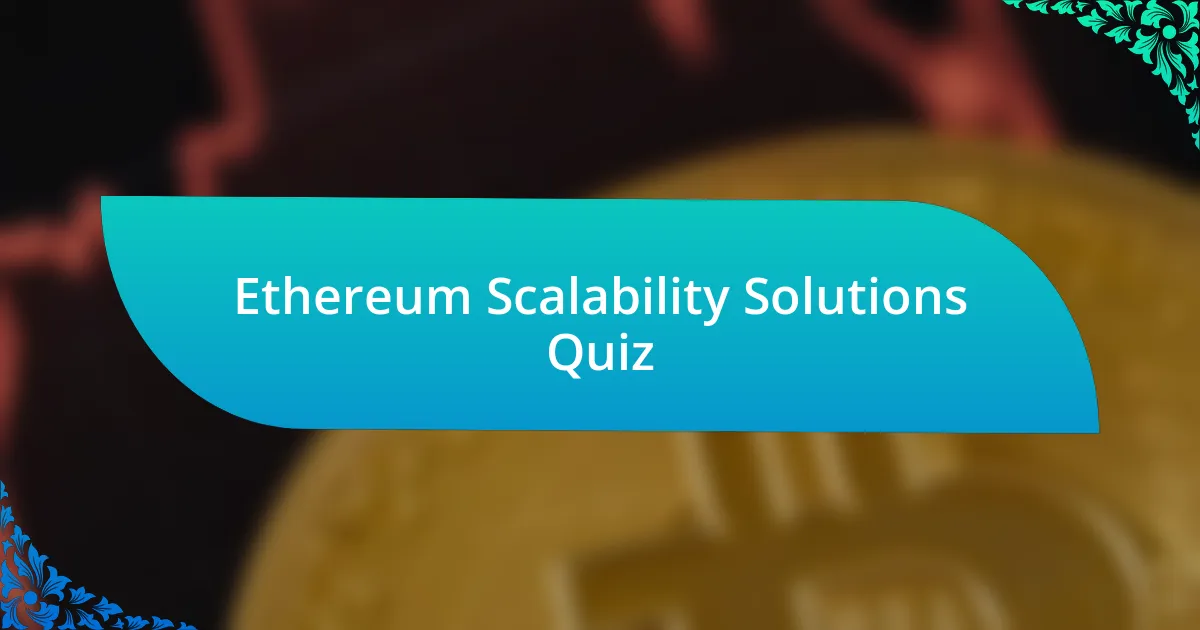
Start of Ethereum Scalability Solutions Quiz
1. What are Ethereum Layer 2 solutions?
- Layer 2 solutions are decentralized applications built solely for trading NFTs on Ethereum.
- Layer 2 solutions are frameworks that improve transaction efficiency on Ethereum by operating above the base chain.
- Layer 2 solutions are alternative cryptocurrencies created to replace Bitcoin and Ethereum entirely.
- Layer 2 solutions are layers that increase the number of nodes in the Ethereum network to enhance security.
2. What is the primary purpose of Layer 2 solutions?
- Improve network security
- Enhance blockchain scalability
- Manage smart contracts
- Increase mining efficiency
3. How do Layer 2 solutions improve scalability?
- By increasing the size of each blockchain block.
- By offloading transaction processing from the main blockchain.
- By limiting the number of users on the network.
- By moving all data on-chain for faster access.
4. What are the benefits of using Layer 2 solutions?
- Slower transaction finality and higher privacy.
- Increased transaction validation time and lower fees.
- Higher transaction throughput and reduced costs.
- Decreased transaction capacity and faster processing.
5. What are the limitations of Layer 2 solutions?
- Increased complexity
- No fees
- Unlimited speed
- Total security
6. What types of transactions can be processed using Layer 2 solutions?
- Traditional banking transactions only
- Only cryptocurrency mining transactions
- Social media interactions and messaging
- Payments, decentralized exchanges (DEXs), gaming, and non-fungible tokens (NFTs)
7. How do state channels work in Layer 2 solutions?
- State channels require all data to be submitted on-chain immediately.
- State channels only function on private blockchains with controlled access.
- State channels automatically close after each transaction without user input.
- State channels allow off-chain transactions using a multisignature contract.
8. What is the role of the Beacon Chain in Ethereum 2.0?
- The Beacon Chain only processes transactions on Layer 2.
- The Beacon Chain functions solely for managing user accounts.
- The Beacon Chain coordinates validators and manages consensus.
- The Beacon Chain is a smart contract for DApps.
9. What is the significance of shard chains in Ethereum 2.0?
- Shard chains allow for parallel processing of transactions, significantly increasing scalability.
- Shard chains are used for enhancing privacy within transactions only.
- Shard chains serve as a storage layer for smart contracts exclusively.
- Shard chains prioritize security over scalability and throughput.
10. What is the consensus algorithm used by Ethereum?
- Byzantine Fault Tolerance
- Proof of Stake
- Proof of Work
- Delegated Proof of Stake
11. What is the primary benefit of Ethereum scaling solutions?
- Limited to specific transaction types
- More complex smart contracts
- Significant improvement in scalability
- Increased transaction fees
12. How do Layer 2 solutions address network congestion?
- Layer 2 solutions resolve congestion by randomly dropping old transactions to minimize the load.
- Layer 2 solutions address network congestion by processing transactions off-chain, reducing the load on the main chain and enabling faster transactions.
- Layer 2 solutions increase gas fees by conducting all operations on-chain, which can slow down the network.
- Layer 2 solutions create additional layers on the main chain that add complexity without improving speed.
13. What is the role of Optimistic Rollups in Layer 2 solutions?
- Optimistic Rollups eliminate the need for any transaction fees by storing everything off-chain.
- Optimistic Rollups involve manual validation of each transaction by the users before processing.
- Optimistic Rollups require all transactions to be verified on-chain without exceptions.
- Optimistic Rollups validate transactions off-chain and use on-chain storage for final settlements.
14. What is the role of Zero-Knowledge (zk) Rollups in Layer 2 solutions?
- Zero-Knowledge (zk) Rollups allow users to operate entirely anonymously without any cryptographic methods.
- Zero-Knowledge (zk) Rollups eliminate the need for any transactions on the Ethereum blockchain.
- Zero-Knowledge (zk) Rollups use cryptographic proofs for enhancing security and privacy in transactions.
- Zero-Knowledge (zk) Rollups only help to speed up the mining process for Ethereum blocks.
15. How do Layer 2 solutions impact transaction costs?
- Layer 2 solutions have no effect on transaction costs and keep them constant.
- Layer 2 solutions increase gas fees by processing all transactions on-chain.
- Layer 2 solutions minimize gas fees associated with on-chain transactions, making it more cost-effective for users to interact with the L1.
- Layer 2 solutions double the costs for each transaction processed off-chain.
16. What is the significance of Ethereum 2.0 in improving scalability?
- Ethereum 2.0 focuses solely on improving user experience, which indirectly addresses scalability issues.
- Ethereum 2.0 introduces shard chains, which allow for parallel transaction processing, significantly enhancing scalability.
- Ethereum 2.0 reduces the block time to 5 seconds, which increases transaction speed but does not enhance scalability.
- Ethereum 2.0 eliminates all gas fees, making transactions free and significantly improving scalability.
17. How do Layer 2 solutions enhance user experience?
- Layer 2 solutions enhance user experience by enabling faster and cheaper transactions.
- Layer 2 solutions make transactions slower and more expensive.
- Layer 2 solutions only work during peak network hours.
- Layer 2 solutions eliminate all transaction fees for users.
18. What are some real-world applications of Layer 2 solutions?
- Social media platforms
- Payments, DEXs, gaming, and NFTs
- Web hosting services
- Cloud storage solutions
19. How do state channels improve privacy?
- State channels do not offer any privacy benefits and process all transactions transparently on the main chain.
- State channels keep transaction details off-chain and only submit the final state to the main chain, enhancing privacy.
- State channels rely on central authorities to manage and oversee all transactions, ensuring privacy.
- State channels require all transaction details to be visible on the main chain, which improves privacy.
20. What is the TVL of Ethereum scaling solutions?
- $20 billion
- $15.5 billion
- $5 billion
- $10 billion
21. What is the impact of DeFi on Ethereum Layer 2 networks?
- DeFi has resulted in higher transaction fees on Ethereum Layer 2 networks.
- DeFi has limited the adoption of Ethereum Layer 2 networks.
- DeFi has decreased the demand for Layer 2 solutions on Ethereum.
- DeFi has been a significant catalyst in the growth of Ethereum Layer 2 networks.
22. Which Layer 2 solutions are currently popular?
- Solana
- Cardano
- Optimism
- Avalanche
23. How do Layer 2 solutions reduce gas fees?
- Layer 2 solutions increase gas fees by adding more transactions to the main chain to improve efficiency.
- Layer 2 solutions reduce gas fees by processing transactions off-chain and then batching them together for settlement on the base layer.
- Layer 2 solutions eliminate gas fees entirely by allowing transactions to occur solely off the main blockchain.
- Layer 2 solutions require higher gas fees on every transaction to ensure network security and reliability.
24. What is the role of the Beacon Chain in Ethereum 2.0’s phased rollout?
- The Beacon Chain coordinates consensus for Ethereum 2.0.
- The Beacon Chain is solely responsible for payment processing.
- The Beacon Chain runs smart contracts independently.
- The Beacon Chain tracks ERC-20 token transactions.
25. What is the significance of the Ethereum Dencun upgrade?
- The Ethereum Dencun upgrade introduces new cryptocurrencies.
- The Ethereum Dencun upgrade eliminates smart contracts.
- The Ethereum Dencun upgrade centralizes the Ethereum network.
- The Ethereum Dencun upgrade reduces gas fees on Layer-2 networks.
26. How do Layer 2 solutions address liquidity fragmentation?
- Layer 2 solutions eliminate all fees associated with transactions.
- Layer 2 solutions create new coins that don`t require bridging.
- Layer 2 solutions restrict transactions to a single network only.
- Layer 2 solutions address liquidity fragmentation by providing bridging mechanisms to move assets between different networks.
27. What is the dependency of Layer 2 solutions on L1?
- Layer 2 solutions operate solely on their own without L1.
- Layer 2 solutions are completely independent of L1 blockchains.
- Layer 2 solutions depend on L1 for security and settlement.
- Layer 2 solutions do not rely on the main chain at all.
28. What is the functionality of Truffle in Ethereum development?
- Truffle is a popular testing and development environment for Ethereum, offering an asset pipeline to handle Ethereum-based projects.
- Truffle is a cryptocurrency wallet for managing Ethereum assets.
- Truffle is a mining tool that increases transaction speed on Ethereum.
- Truffle is a blockchain used for creating consensus mechanisms in Ethereum.
29. What is the block time and average block size in Ethereum?
- The block time is 20 seconds, and the average block size is 500 KB.
- The block time is 14 seconds, and the average block size is 2 KB.
- The block time is 30 seconds, and the average block size is 5 KB.
- The block time is 10 seconds, and the average block size is 1 MB.
30. Can transactions be kept hidden in the public Ethereum network?
- No, all transactions are public in the Ethereum network.
- Transactions are hidden but traceable by authorities.
- Yes, transactions can be completely private on Ethereum.
- Only specific transactions can be kept hidden in the network.

Congratulations, You’ve Completed the Quiz!
Thank you for participating in our quiz on Ethereum scalability solutions! We hope you found the experience enjoyable and insightful. This quiz was designed to test your knowledge and deepen your understanding of key concepts related to Ethereum’s scalability challenges and the various solutions being developed to address them. From layer 2 protocols to sharding, each component plays a significant role in the future of Ethereum.
Throughout this quiz, you may have learned about different techniques designed to improve transaction speeds and reduce costs on the Ethereum network. Understanding these advancements not only helps you grasp the current landscape of blockchain technology but also prepares you for future developments. The importance of scalability in ensuring the success and widespread adoption of Ethereum cannot be overstated.
If you’re eager to learn more, we invite you to explore the next section on this page dedicated to Ethereum scalability solutions. It’s packed with in-depth information that will further enrich your knowledge. Join us as we dive into the future possibilities for Ethereum and how they may reshape the blockchain ecosystem.

Ethereum Scalability Solutions
Understanding Ethereum Scalability
Ethereum scalability refers to the network’s ability to handle a growing number of transactions without compromising speed or efficiency. As the number of users increases, the demand for transactions rises, creating congestion. Ethereum’s original design allowed for about 15 transactions per second (TPS), which is insufficient for widespread adoption. To solve this, developers explore various strategies aimed at increasing capacity while maintaining decentralization and security.
Layer 1 Solutions for Ethereum
Layer 1 solutions operate directly on the Ethereum blockchain. They enhance the network’s base protocol to improve scalability. Examples include Ethereum 2.0, which transitions to a proof-of-stake (PoS) consensus mechanism. This change is expected to increase throughput significantly, potentially allowing thousands of transactions per second. Implementing sharding will also distribute data storage and processing, further improving scalability.
Layer 2 Solutions and their Mechanisms
Layer 2 solutions build on top of the Ethereum blockchain to increase scalability. They process transactions off the main chain before settling them back on Ethereum. Notable examples are Rollups, which bundle multiple transactions into a single one to reduce load. Optimistic Rollups and Zero-Knowledge Rollups (ZK-Rollups) represent the two main types. Both aim to lower costs and increase transaction speed while maintaining Ethereum’s security protocols.
Sidechains and Their Impact on Scaling
Sidechains are separate blockchains that run parallel to Ethereum. They allow for transactions and smart contracts independently of the main Ethereum chain. This reduces congestion on Ethereum’s network. Users can transfer assets between the sidechain and Ethereum, facilitating faster transactions. Notable examples include Polygon and xDAI. These sidechains have proven effective in enhancing scalability while maintaining low transaction fees.
Future Prospects of Ethereum Scalability
The future of Ethereum scalability looks promising as more solutions are implemented. Continued development of Layer 1 and Layer 2 solutions, alongside the transition to Ethereum 2.0, aims to drastically improve transaction throughput. Furthermore, interoperability with other blockchains will enhance the ecosystem’s usability. As Ethereum evolves, the network’s capacity will likely increase substantially, boosting its role in the blockchain space.
What are Ethereum scalability solutions?
Ethereum scalability solutions are methods or technologies designed to increase the throughput of the Ethereum network. They address the network’s limitations in handling a high volume of transactions effectively. Solutions include Layer 2 technologies like Rollups, which process transactions off the main Ethereum chain while still benefiting from its security, and Sharding, which divides the Ethereum network into smaller, more manageable pieces. These solutions aim to enhance speed, reduce transaction costs, and improve user experience on the platform.
How do Ethereum scalability solutions work?
Ethereum scalability solutions work by redistributing the transaction load across the network. Layer 2 solutions, such as Optimistic and ZK-Rollups, bundle multiple transactions into a single transaction processed on the main Ethereum chain. Sharding divides the network into smaller segments, allowing different groups of validators to confirm transactions simultaneously. This parallel processing increases the total number of transactions the network can handle at once, thereby improving scalability.
Where are Ethereum scalability solutions implemented?
Ethereum scalability solutions are implemented on the Ethereum blockchain ecosystem. Layer 2 solutions operate on top of the Ethereum network and can be accessed through various decentralized applications (dApps) and wallets. They are also integrated into protocols like Polygon and Optimism, which enhance transaction throughput. Sharding is part of Ethereum 2.0, which is being developed to improve the base layer of the Ethereum network.
When were Ethereum scalability solutions first proposed?
Ethereum scalability solutions were first proposed shortly after the network launched in 2015. Discussions around the need for scalability became prominent around 2016 with the emergence of projects designed to address high transaction fees and slow processing times. The introduction of Layer 2 solutions like Plasma in 2017 marked a significant step in scaling efforts. Sharding has been part of Ethereum’s long-term roadmap since 2018, with ongoing development aimed at its implementation.
Who is developing Ethereum scalability solutions?
Ethereum scalability solutions are being developed by various teams and organizations in the blockchain community. The Ethereum Foundation oversees much of the development work related to scaling the network. Additionally, companies and projects like Optimism, Polygon, and Arbitrum are key players in advancing Layer 2 solutions. The open-source nature of Ethereum allows developers worldwide to contribute to its scalability innovations.

